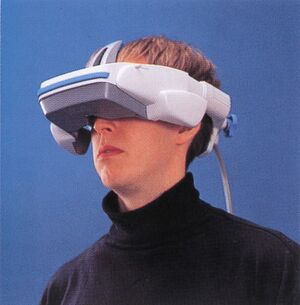Difference between revisions of "Virtual reality"
From Sega Retro
m |
|||
| Line 30: | Line 30: | ||
*[[Sega B.O.X. System]] | *[[Sega B.O.X. System]] | ||
*[[Sega VR]] (unreleased) | *[[Sega VR]] (unreleased) | ||
| + | *[[Virtua Visor]] (unreleased) | ||
==List of attractions== | ==List of attractions== | ||
Revision as of 22:17, 6 September 2023

Virtual reality is a simulated experience made to imitate or contrast the real world. Over the years since its inception, it has been applied to numerous fields and has taken on several forms, but its most recognised type in recent years is that of a head-mounted display used for immersive entertainment, frequently video games. Methods for it have additionally been defined and achieved through the use of large screens in specially-designed environments, such as CAVE rooms. Though often touted as "the future", VR has been through numerous periods of public acceptance, indifference, and derision, with its technology still developing.
As part of its attempts to stay at the forefront of high-technology, Sega became involved in research and development of VR hardware and software during the 1990s. Its advanced Mega Visor Display saw a limited release in Sega Net Merc, an arcade system, and VR-1, a large attraction for Amusement Theme Parks. Sega-developed simulation attractions made to give off the illusion of VR, meanwhile, have also included AS-1 and The Crypt, the latter utilizing the CAVE-like Sega B.O.X. System and active shutter 3D glasses.
Sega of America's only consumer VR hardware effort to date, Sega VR, went unreleased; public health concerns and PAL conversion issues problematized its development. In addition, the Mega Visor Display was used as framework for Virtua Visor, an unannounced augmented reality add-on for the Saturn.[1]
Following the creation and success of more refined virtual reality offerings for the home during the 2010s, including the Oculus Rift and PlayStation VR, Sega has returned to the prospect of consumer VR with licenced and in-house software. It has also installed free-roaming VR arenas from other companies in venues including Tokyo Joypolis and presented them at events such as Japan Amusement Expo.
List of software
- Iron Hammer (unreleased)
- Matrix Runner (unreleased)
- Nuclear Rush (unreleased)
- Outlaw Racing (unreleased)
- Dennou Senki Net Merc
- Space Mission
- Persona 3: Dancing in Moonlight
- Persona 5: Dancing in Starlight
- Planet Adventure
- Hatsune Miku: VR Future Live
- Sega Mega Drive Classics
- Space Channel 5 VR Kinda Funky News Flash!
List of hardware
- Mega Visor Display
- Sega Net Merc
- Sega B.O.X. System
- Sega VR (unreleased)
- Virtua Visor (unreleased)